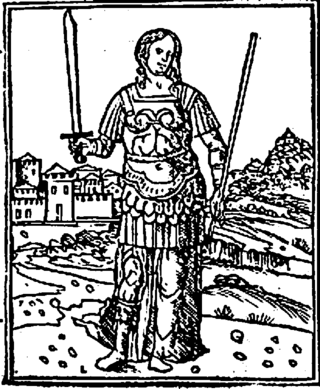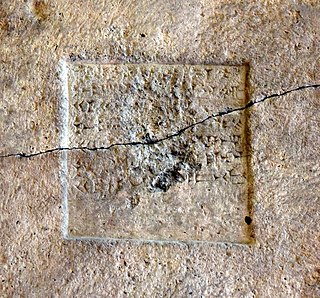Related Research Articles

In Greek mythology, Omphale was princess of the kingdom of Lydia in Asia Minor. Diodorus Siculus provides the first appearance of the Omphale theme in literature, though Aeschylus was aware of the episode. The Greeks did not recognize her as a goddess: the undisputed etymological connection with omphalos, the world-navel, has never been made clear. In her best-known myth, she is the mistress of the hero Heracles during a year of required servitude, a scenario that, according to some, offered writers and artists opportunities to explore sexual roles and erotic themes.

Ninus, according to Greek historians writing in the Hellenistic period and later, was the founder of Nineveh, ancient capital of Assyria. The figure or figures with which he corresponds in Assyrian records is uncertain; an association or identification with Ninurta has been proposed. An identification with Shamshi-Adad I, Shamshi-Adad V, and/or a conflation of the two have also been suggested.

Semiramis was the legendary Lydian-Babylonian wife of Onnes and of Ninus, who succeeded the latter on the throne of Assyria, according to Movses Khorenatsi. Legends narrated by Diodorus Siculus, who drew primarily from the works of Ctesias of Cnidus, describe her and her relationships to Onnes and King Ninus.

Belus or Belos in classical Greek or classical Latin texts in an Assyrian context refers to one or another purportedly ancient and historically mythical Assyrian king, such king in part at least a euhemerization of the Babylonian god Bel Marduk. It is likely that this Assyrian Belus should mostly not be distinguished from the euhemerized Babylonian Belus, but some chronographers make a distinction between them.

The Two Babylons, subtitled Romanism and its Origins, is a book that started out as a religious pamphlet published in 1853 by the Presbyterian Free Church of Scotland theologian Alexander Hislop (1807–65).

Chief Daniel Olorunfẹmi Fágúnwà MBE, popularly known as D. O. Fágúnwà, was a Nigerian author of Yorùbá heritage who pioneered the Yorùbá language novel.

Shammuramat, also known as Sammuramat or Shamiram and Semiramis, was a powerful queen of the Neo-Assyrian Empire. Beginning her career as the primary consort of the king Shamshi-Adad V, Shammuramat reached an unusually prominent position in the reign of her son Adad-nirari III. Though there is dispute in regard to Shammuramat's formal status and position, and if she should be considered a co-regent, it is clear that she was among the most powerful and influential women of the ancient Near East; she is the only known Assyrian queen to have retained her status as queen after the death of her husband and the only known ancient Assyrian woman to have partaken in, and perhaps even led, a military campaign.
Ninu's Cave is a cave in Xagħra, Gozo, Malta. Ninu's Cave was discovered by local resident Joseph Rapa in 1888 while digging a well under a private house. Ninu's Cave is not far from another underground feature, Xerri's Grotto, also discovered when a well was being dug under a private house.
Ninu Zammit is a former Maltese politician, widely known for being suspended from the Nationalist party after an exposé of $3.4 million in his secret Swiss bank account in 2015. He served as a Nationalist MP since 1981, Parliamentary Secretary for Water and Energy (1987–92), Minister of Agriculture (1998–2003) and Minister of Resources and Infrastructure (2003–2008).
Emil Ducu Ninu is a Romanian footballer who currently plays as a defender for Liga IV side Venus Independența.
Meena Kapoor was an Indian playback singer. She was the daughter of actor Bikram Kapoor who worked with the New Theatres studio. Her family was also related to famed filmmaker PC Barua. Meena's singing was noticed at a young age by composers like Ninu Mazumdar and SD Burman. She was a playback singer in Hindi cinema, during the 1940s and 1950s, singing hits such as "Rasiya Re Man Basiya Re" from Pardesi (1957), Ek Dharti Hai Ek Gagan from Adhikar (1954) and 'Kachhi hai Umariya' picturised on Meena Kumari in Char Dil Char Rahen (1959). She was a friend of the singer Geeta Dutt; the two had similar vocal styles.
Daedala or Daidala was a city of the Rhodian Peraea in ancient Caria, or a small place, as Stephanus of Byzantium says, on the authority of Strabo.

Igbó Olódùmarè is the second novel by the Yorùbá author D.O. Fágúnwà, published in 1949 by Thomas Nelson. It is a prequel to his first book and details the adventures of Olowo-Aiye, the father of the protagonist in Ògbójú Ọdẹ nínú Igbó Irúnmọlẹ̀
Paristan is a 1944 Indian Hindi-language fantasy film. The film was directed by Mahesh Kaul for Acharya Art productions. It starred Pahari Sanyal, Anjali Devi, Kamal Zamindar, Sunalini Devi, Moni Chatterjee and Padma Bannerjee. The music was composed by Ninu Majumdar and the lyrics were by Roopdas and Ninu Majumdar. This was Mahesh Kaul's second film after Angoori (1943).

Delias ninus, the Malayan Jezebel, is a butterfly in the family Pieridae. It was described by Alfred Russel Wallace in 1867. It is found in the Indomalayan realm.

Ninidae is a family of true bugs in the order Hemiptera. There are about 5 genera and 14 described species in Ninidae.

Wildfowler was an Irish-bred, British-trained Thoroughbred racehorse and sire. He showed very good form as a two-year-old in 1897 when he won three of his five races and finished third in the Middle Park Plate. In the following year he ran fourth in the 2000 Guineas and was fancied for the Epsom Derby before being scratched from the race. He returned in September to win the St Leger, upsetting the Derby winner Jeddah but did not race again. He stood as a breeding stallion in Ireland and France but was not a great success although he did sire a top-class performer in Llangibby and an influential broodmare in Silver Fowl.
Disraeli (1895–1911) was a British Thoroughbred racehorse and sire. As a juvenile in 1897 he showed considerable promise by winning the Champion Breeders' Foal Plate at Derby Racecourse and then finishing second in the Middle Park Plate. In the following spring he recorded his biggest win in the 2000 Guineas but disappointed when favourite for the Epsom Derby and later ran unplaced in the St Leger. He made no impact as a breeding stallion in France.

Sémiramis (1746) is a tragedy in five acts by Voltaire, first performed in 1748 and published in 1749.

Ninu Veedani Needanu Nene is a 2019 Indian Telugu supernatural romantic thriller film written and directed by Caarthick Raju. The film stars Sundeep Kishan, Anya Singh, Vennela Kishore, Pragathi, and Murali Sharma in the lead roles. The film was simultaneously shot in Tamil titled Kannaadi; however, the Tamil version remains unreleased. The music of the film was composed by S. Thaman and was theatrically released on 12 July 2019.
References
- ↑ Perry, Ben E. (28 July 2023). The Ancient Romances: A Literary-Historical Account of Their Origins. Univ of California Press. p. 165. ISBN 978-0-520-31372-9.